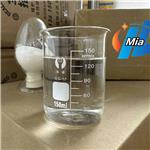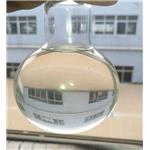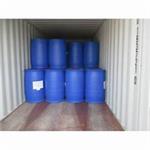Glycidol is a chiral molecule with epoxide and primary alcohol
functional groups. It is racemic mixture and exists in the
dextrorotatory and the levorotatory enantiomeric forms.
Several synthetic methods are available for preparation of glycidol.
However, it is commercially prepared from the epoxidation
of allyl alcohol with hydrogen peroxide and a catalyst
(tungsten or vanadium), or from the reaction of epichlorohydrin
with caustic. Glycidol has been used in the industrial
synthesis of pharmaceutical products since the 1970s.
However, its use for research purposes has been reported since
1956. Available information indicates that glycidol is manufactured
by several companies in Japan, Germany, and the
United States.
Glycidol is a colorless liquid.
Stabilizer in manufacturing of vinyl polymers; intermediate in synthesis of glycerol, glycidyl ethers, and amines; additive for oil and synthetic hydraulic fluids; epoxy resin diluent.
Glycidol is used as a stabilizer for natural oilsand vinyl polymers, as a demulsifier, and asa leveling agent for dyes.
Glycidol is a Stabilizer in the manufacture of vinyl polymers; chemical intermediate in preparation of glycerol, glycidyl ethers, esters, and amines; in pharmaceuticals; in sanitary chemicals.
Odorless clear colorless liquid.
Glycidol is sensitive to moisture. Glycidol is also sensitive to light. Glycidol may polymerize if heated above room temperature. Glycidol may darken on storage. Stability studies of Glycidol stored for two week protected from light indicated definite decomposition at 140° F, and strongly indicated instability at 77° F. A solution of Glycidol in water was found to be unstable when stored at room temperature, even after one day in the dark. Glycidol is incompatible with strong oxidizers. Glycidol will undergo explosive decomposition in the presence of strong acids or bases, salts (such as aluminum chloride, iron(III)chloride or tin(IV) chloride) or metals (such as copper and zinc). Glycidol is also incompatible with nitrates. Glycidol will attack some forms of plastics, rubber and coatings.
Toxic material. Probable carcinogen.
Glycidol is an eye, lung, and skin irri-tant. The pure compound caused severebut reversible corneal injury in rabbit eyes(ACGIH 1986). Exposure to its vapor causedirritation of lung in mice, resulting in pneu-monitis. There is no evidence of any cumula-tive toxicity. From the limited toxicity data,it appears that the health hazard to humansfrom its exposure is, primarily, respiratoryirritation, stimulation of the central nervoussystem, and depression.
Glycidol is mutagenic, testing positive inthe histidine reversion–Ames test. There isno report of its carcinogenic action. Oraland intraperitoneal administration of gly-cidol in rats showed harmful effects onfertility.
Flammability and Explosibility
Non flammable
Confirmed carcinogen
with carcinogenic data reported. Poison by
intraperitoneal route. Moderately toxic by
ingestion, inhalation, and sh contact.
Experimental teratogenic and reproductive
effects. A skin irritant. Human mutation
data reported. Animal experiments suggest
somewhat lower toxicity than for related
epoxy compounds. Readdy absorbed
through the skin. Causes nervous excitation
followed by depression. Explodes when
heated or in the presence of strong acids,bases, metals (e.g., copper, zinc), and metal
salts (e.g., aluminum chloride, iron(II1)
chloride, tin(Iy chloride). When heated to decomposition it emits acrid smoke and
fumes. See also DIGLYCIDYL ETHER.
Glycidol is used as an intermediate in
the synthesis of glycerol, glycidyl ethers, esters, and amines.
Glycidol is reasonably anticipated to be a human carcinogen based on sufficient evidence of carcinogenicity from studies in experimental animals.
Chemical/Physical. May hydrolyze in water forming glycerin (Lyman et al., 1982).
UN2810 Toxic liquids, organic, n.o.s., Hazard
Class: 6.1; Labels: 6.1-Poisonous materials, Technical
Name Required.
[S(-)-isomer, § also available on polymer support, has b 49-50o/7mm, 66-67o/19mm, [� ] D -1 5o(neat)], [R(+)-isomer has b 56 -5 6 . 5o/11mm, d 4 1.117, n D 1.429, [� ] D +15o (neat)]. Purify glycidol by fractional distillation.
Glycidol is a small molecule possessing a chemically reactive
epoxide group. Therefore, it acts as a direct alkylating agent.
Nucleophilic bioactive compounds such as glutathione react
readily with glycidol. Glycidol decreases glutathione content in
rat liver by direct binding to the glutathione. In vitro experiments
revealed that glycidol reacts with purified DNA to form
the DNA adducts. This is likely to be responsible for the genotoxic
activity of the compound without a requirement for
metabolic activation.
May form explosive mixture with air.
Violent reaction with strong oxidizers, nitrates.
Decomposes on contact (especially in the presence of heat)
with strong acids, strong bases, water, metal salts, e.g., alu minum chloride, ferric chloride, and tin chloride), or metals
(copper and zinc), causing fire and explosion hazard.
Contact with barium, lithium, sodium, magnesium, and tita nium may cause polymerization. Attacks some plastics,
rubber, and coatings.
Concentrated waste contain ing no peroxides: discharge liquid at a controlled rate near
a pilot flame. Concentrated waste containing peroxides:
perforation of a container of the waste from a safe distance
followed by open burning.



